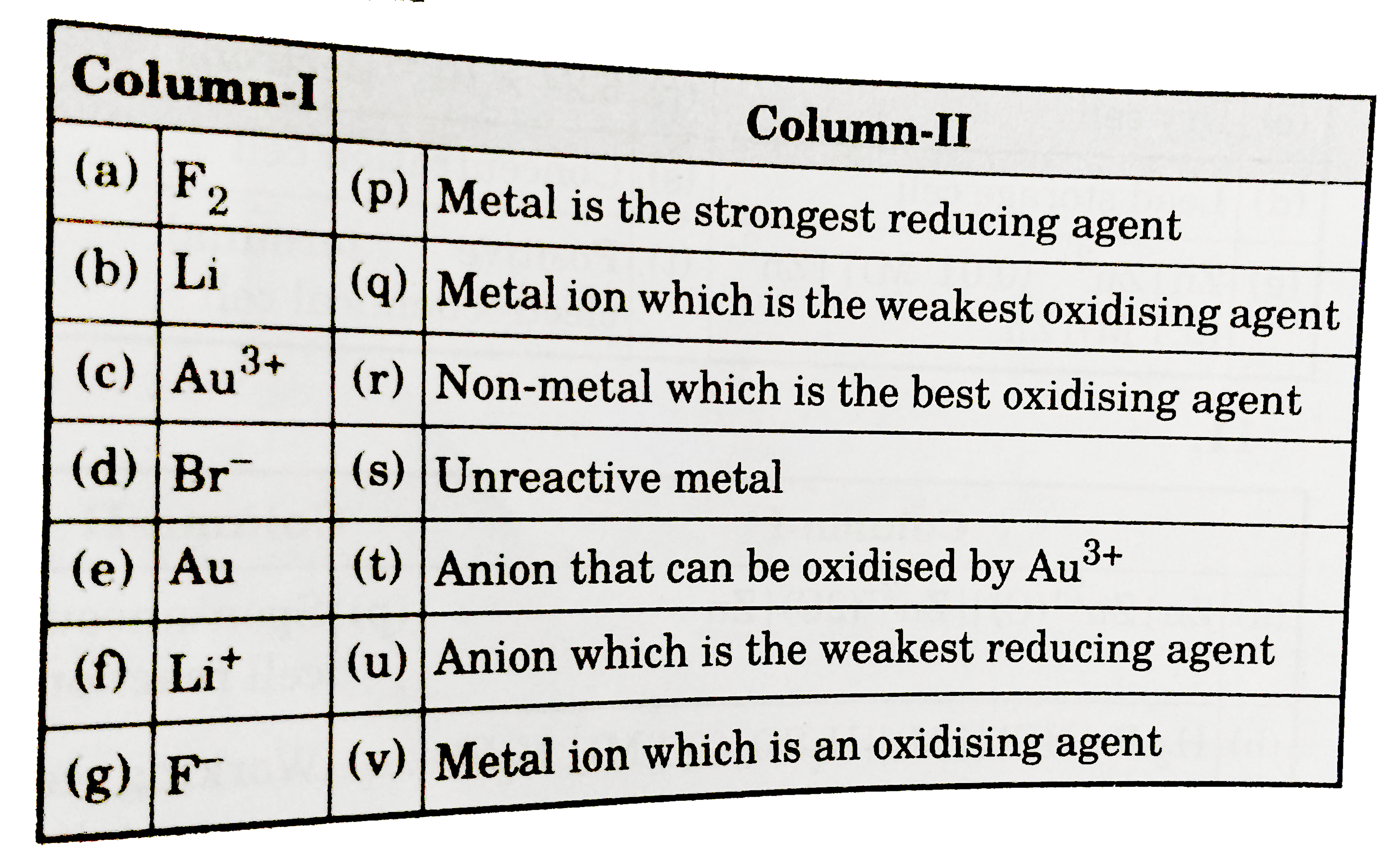Match the items of Column-I and Column-II on the basis of data given below:
EΘF2∣F−=2.87V,EΘLi+∣Li=−3.5V,
EΘAu3+∣Cu=1.4V,EΘBr2∣Br−=1.09V

(A→3),(B→1),(C→7),(D→5),(E→4),(F→2),(G→6)
* The following emf series is obtained by following E∘ value

* Any half cell reaction : A+e−→B
experiencing reduction→product of reduction.
oxidizing agent→reducing agent.
(A) F2 : is non-metal and E∘ is maximum. So F2 is reduced easily and is strongest oxidizing agent.
(B) Li : is metal, apart from this Au is another metal. Between these two metals Li has high E∘ value so Li is strongest oxidizng agent.
(C) Au3+ is metal ion. it has high reduction potential and so Au3+ is oxidizing agent.
(D) Br− is negative ion. Oxidation half reaction:
Br−→12Br So, oxidation of Br− is occur.
3Br−→32Br2+3e− (Oxidation) EΘ=1.09V
Au3++3e−→Au (Reduction) EΘ=1.4V
(E) Au is inert metal because all metals have high E∘ value.
(F) Li+ is metal ions and standard reduction potential is E∘ is low -3.5 V and so it is weak oxidizing agent.
(G) F− is negative ion and its oxidation F−→F2 and so F− is reducing agent and E∘ is maximum so it is weak reducing agent.
Topper's Solved these Questions
- ELECTROCHEMISTRYBOOK - KUMAR PRAKASHANCHAPTER - ELECTROCHEMISTRYEXERCISE - SECTION-D NCERT Exemplar Solution (Assertion and Reason Type)
10 Videos
- ELECTROCHEMISTRYBOOK - KUMAR PRAKASHANCHAPTER - ELECTROCHEMISTRYEXERCISE - SECTION-D NCERT Exemplar Solution (Long Answer Type Questions)
3 Videos
- ELECTROCHEMISTRYBOOK - KUMAR PRAKASHANCHAPTER - ELECTROCHEMISTRYEXERCISE - SECTION-D NCERT Exemplar Solution (Short Answer Type Questions)
22 Videos
- CHEMISTRY IN EVERYDAY LIFEBOOK - KUMAR PRAKASHANCHAPTER - CHEMISTRY IN EVERYDAY LIFEEXERCISE - SECTION - E (MCQs ASKED IN GUJCET/BOARD EXAM)
37 Videos
- GENERAL PRINCIPLES AND PROCESSES OF ISOLATION OF ELEMENTSBOOK - KUMAR PRAKASHANCHAPTER - GENERAL PRINCIPLES AND PROCESSES OF ISOLATION OF ELEMENTSEXERCISE - SECTION - E (MCQs ASKED IN GUJET/BOARD EXAMS)
46 Videos
Similar Questions
Match the items of Column I and Column II on the basis of data given below :
E_(F_(2)//F^(-))^(Ï´)=2.87" V ",E_(Li^(+)//Li)^(Ï´)=3.5" V ",E_(Au^(3+)//Au)^(Ï´)=1.4" V ",E_(Br_(2)//Br^(-))^(Ï´)=1.09" V "

View SolutionMatch the items of Column I and Column II on the basis of data given below:
(One to one match only)
E∘F2∣F− = 2.87 V, ELi+∣(Li) = -3.5 V,
E∘Au3+∣Au = 1.4 V, E∘Br2∣Br− = 1.09V

View Solution
Knowledge Check
Using the data given below:
E∘Cr2O2−7∣Cr3+=1.33VE∘Cl2∣Cl−=1.36V
E∘MnO−4∣Mn2+=1.51VECr3+∣Cr=−0.74V
Mark the strongest reducing agent.ACl−BCrCCr3+DMn2+On the basis of data given below,
E∘Sc3+/Sc2+=−0.37V,E∘Mn3+/Mn2+=+1.57V
E∘Cr2+/Cr=−0.90V,E∘Cu2+/Cu=0.34V
which of the following statements is incorrect?ASc3+ has good stability due to [Ar]3d04s0 configurationBMn3+ is more stable than Mn2+CCr2+ is reducing in nature.DCopper does not give H2 on reaction wwith dil H2SO4Arrange the following metals in increasing order of their reducing power.
[ Given : E∘K+/K=−2.93V,E∘Ag+/Ag=+0.80V,E∘Al3/Al=−1.66V,E∘Au3+/Au=+1.40V,E∘Li+/Li=−3.05V]ALi<K<Al<Ag<AuBAu<Ag<Al<K<LiCK<Al<Au<Ag<LiDAl<Ag<Au<Li<K
Match the items of Column I and Column II on the basis of data given below:
(One to one match only)
E∘F2∣F− = 2.87 V, ELi+∣(Li) = -3.5 V,
E∘Au3+∣Au = 1.4 V, E∘Br2∣Br− = 1.09V

View SolutionAn aqueous solution containing 1M each of Au+3,Cu+2,Ag+,Li+ is being electrolysed using inert electrodes the value of standard potentials are
EθAg+/Aga=0.80V,Eθcu2+Cu=0.34V,EθAu3+/Au=1.50V,EθLi+/Li=−3.03V With increasing voltage, find the sequence of deposition of metals on the cathode.
View SolutionWhy zinc coating protects iron more effectively than tin coating ?
Given EΘZn2+/Zn=−0.76V,
EΘSn2+/Sn=−0.14V,EΘFe2+/Fe=−0.44V
View SolutionOut of Zn and Cu vessel one will be more suitable to store 1 M HCl?
Given EθZn2+/Zn=−0.76V,EθCu2+/Cu=+0.34V.
View SolutionArrange the following metals in increasing order of their reducing power.
E∘K+/K=−2.93V,E∘Ag+/Ag=+0.80V,E∘Al3/Al=−1.66VE∘Au3+/Au=+1.40V,<br>E∘Li+/Li=−3.05V
View Solution
